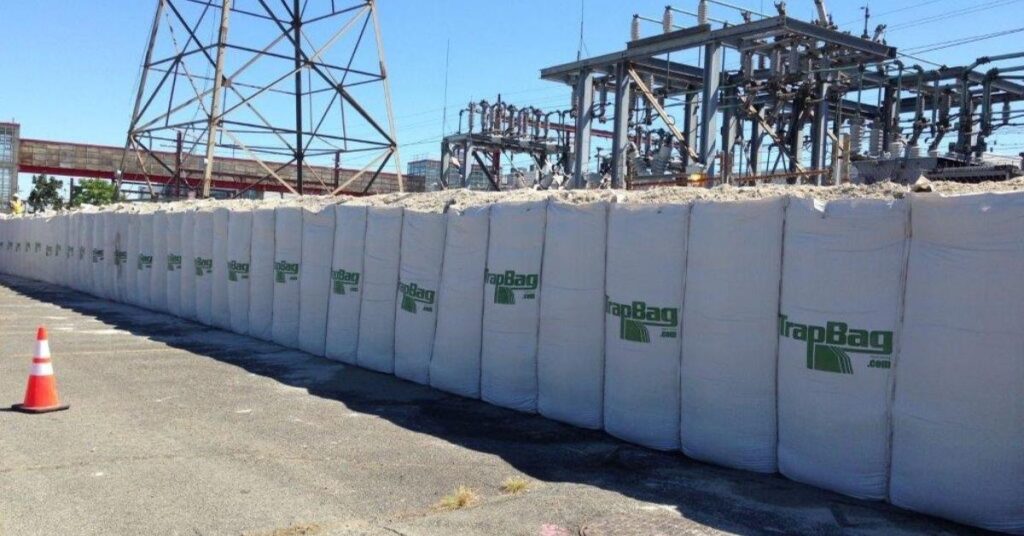Flood Barriers for Buildings
Flooding can permanently lower the value of a building, and cause thousands of dollars in damage. TrapBag offers flood barriers for buildings to keep your home safe.

Flood barriers for buildings help prevent water intrusion during storms, hurricanes, or rising water levels. Options include sandbags, water-filled tubes, and advanced systems like TrapBag®, which offers fast deployment and strong protection for both residential and commercial properties.
Where Should a Flood Barrier Be Deployed?
Flood barriers should be deployed wherever there is potential for floodwaters to reach a building or important infrastructure. They have been used to protect homes, businesses, construction sites, public service centers, and vital infrastructures, such as roads and bridges. Water barriers can be especially important in protecting chemical plants or factories, where flooding could cause toxic substances to enter the groundwater.
How to Build a Flood Barrier
TrapBags can be filled with sand, washed gravel, or concrete. Typically, two ground laborers and a front-end loader can deploy and fill a 300-ft section of four-foot-tall TrapBags per hour with minimal training. Our TrapBag staff would be happy to talk to you about the process.
How Tall Should My Flood Barrier Be?
A single TrapBag placed standing up is four feet high, which will take care of most situations. But for some areas near the ocean where flooding might exceed that level, you may need to build a taller flood barrier. A great method is to do your research on past flooding in your area to get a sense of where the floodwaters may come from and where you should place a barrier. Then, contact the experts at TrapBag to discuss your specific situation and how to build a wall that can protect your property.
When Should I Order Flood Bags?
Flooding can be unpredictable. Just this year, parts of both Texas and Florida experienced their worst storms in nearly 100 years. Around 50% percent of homes flooded every year flooded homes are not in the United States’ recognized flood plain.
TrapBag is an international company based in the USA, with the ability to ship internationally. We can respond immediately to supply and deploy TrapBags where and when needed. Even so, if you think you might be at risk, it’s never too soon to start planning for the next storm so you aren’t competing with your neighbors when the weather forecasts turn sour.
How Many Flood Bags Should I Use?
Our experts at TrapBag are happy to talk with you about your specific situation and discuss how, where, and how many TrapBags should be deployed to form an effective flood barrier to protect your home or business.
Can a Flood Barrier Protect Against a Hurricane?
Water barriers like TrapBag have been proven to be effective against hurricanes and storm surges. They can be easily installed to form temporary or permanent flood protection barriers.
TrapBags vs. Sandbags
Versatile
TrapBags are designed to be used in a broad variety of situations. They have been used to save lakeside cottages from erosion, protect construction sites, and build sea walls. They can be filled with sand, washed gravel, or concrete to create temporary or permanent barriers against rainwater and mudslides.
Durable and Dependable
The engineering experts at TrapBag designed the bags in a pentagon shape, so the bags create cell-like structures for an extremely durable flood barrier. Even if one cell fails, the others remain connected and reinforce each other to keep the barrier in place.
Quick and Simple to Deploy
TrapBags are designed to be deployed quickly with minimal training. Each flood bag uses 40% less filler than sandbags, making them more efficient to build.
Affordable
One 100-ft stretch of a four-foot-tall TrapBag barrier can replace up to 8,000 sandbags and doesn’t require any special materials to fill. TrapBags also have a life of at least five years and have been proven to withstand floods, mudslides, and coastal flooding.
Where Has TrapBag Been Used to Prevent Flooding?
TrapBag has been used to prevent flooding across the United States and beyond. Some of our more recent projects include a levee installation in Baton Rouge, Louisiana, mudslide and debris flow protection in Colorado Springs, Colorado, erosion control in Sarasota, Florida, and dune core stabilization in Rockaway Beach, New York.
Additional Ways to Prevent Flooding
Erosion Control
Erosion can eat away at an embankment over the span of years or make it disappear within minutes. Erosion from agriculture and livestock can also decrease the quality of the soil, leading to slower absorption of rain, and increasing the chances of flooding. TrapBag flood barriers and seawalls are a great way to protect shorelines against erosion. It was even used to save a family’s cottage from being destroyed by the shoreline erosion from Lake Michigan.
Sponge Cities
Urban areas are much more vulnerable to flooding than rural or residential areas because the ground cannot soak up water as quickly. New innovations in urban planning include “sponge cities” that increase the number of trees, parks, and landscaping in urban areas that can soak up water more quickly. You can apply those ideas to your own property by planting vegetation that can both quickly soak up water and prevent erosion during a flood.
Community Education
If you live in an area where a flood can occur, it is essential to have a flood plan. Make sure your family knows what to do in the event of a flood, including where the emergency supplies are located and what areas of the property would stay the driest in the event of a flood. You can also be proactive about taking steps to prevent a flood from overwhelming your home or business if one does occur. Make sure all of your drainages, including storm drains and gutters, are clear of debris. Also, be sure there aren’t leaks in the seals around your windows and doors, and that any cracks in the foundation of your home are filled.
Protect Your Home or Building with TrapBag
Our experts at TrapBag are happy to learn about your unique situation and discuss how you can quickly and affordably build a flood barrier to protect your building. Give us a call or message us on WhatsApp. We are available 24/7.
Meet the author
Get the Dirt Before the Flood Hits
Stay ahead of flooding, erosion, and disaster response challenges. The Dirt, TrapBag’s monthly newsletter, delivers field-tested tips, real-world case studies, and the latest in barrier technology straight to your inbox.

